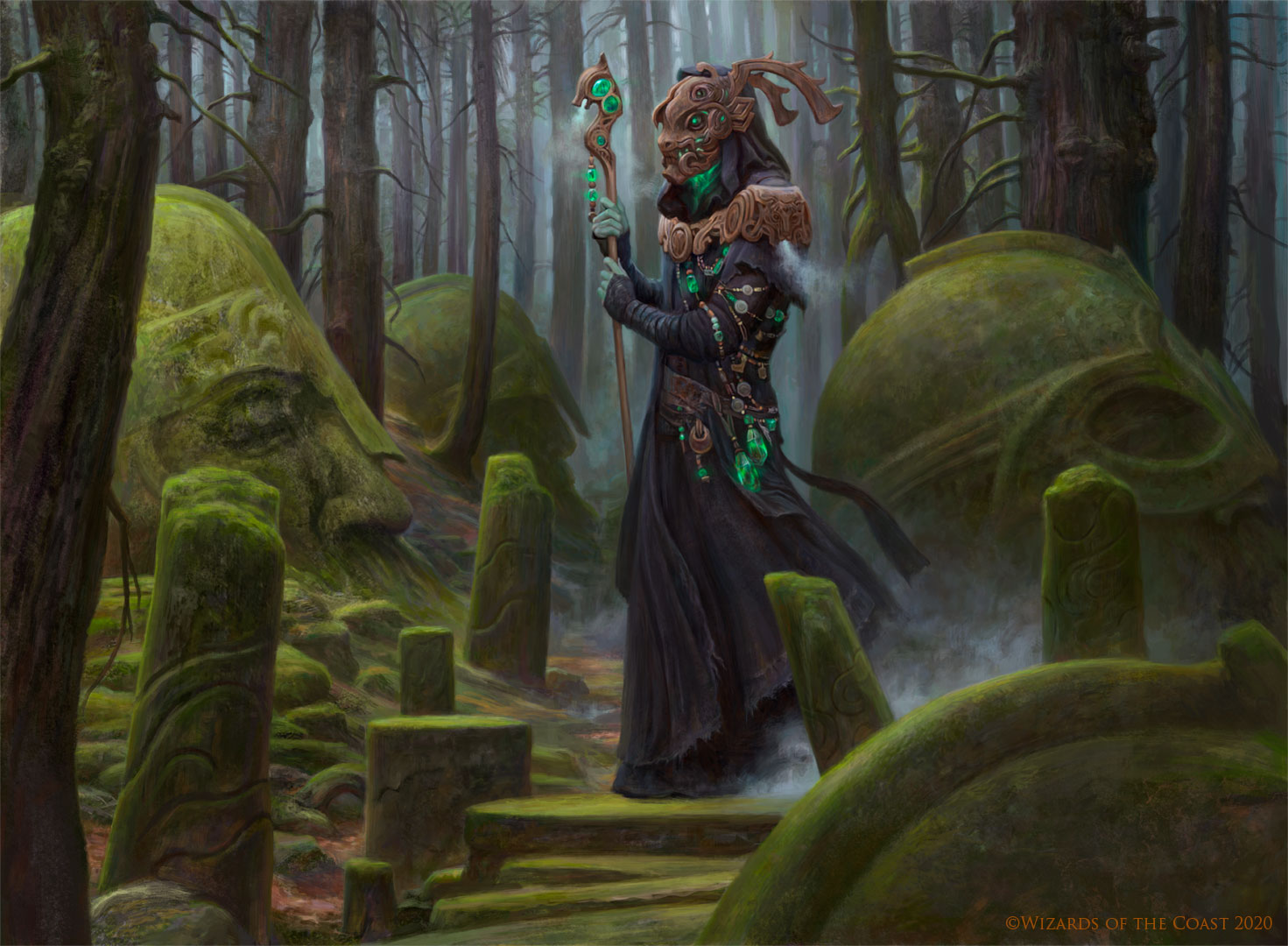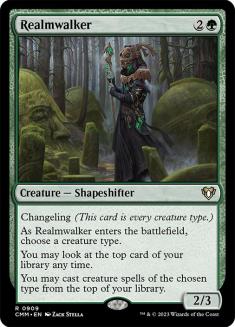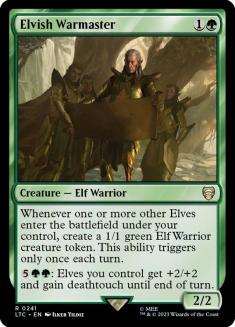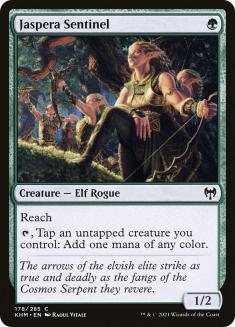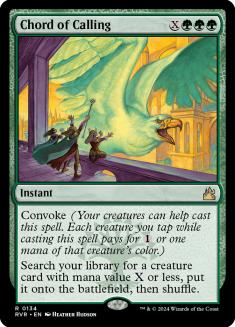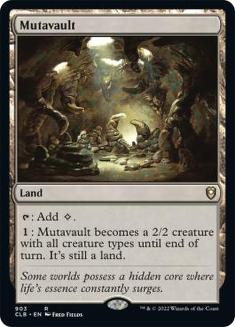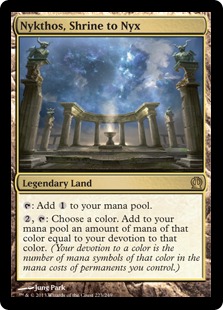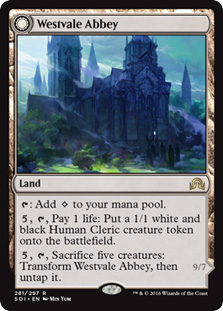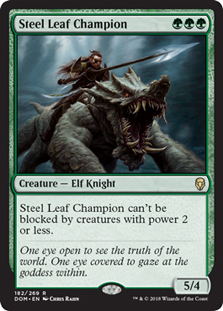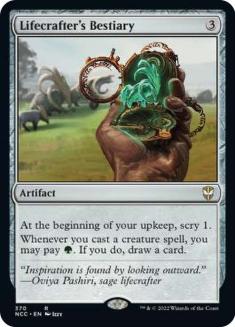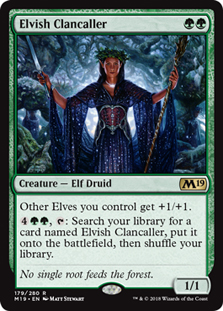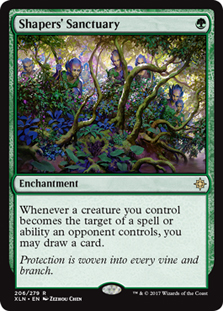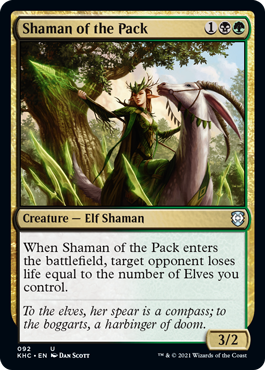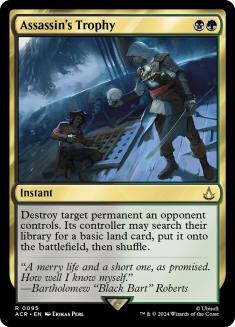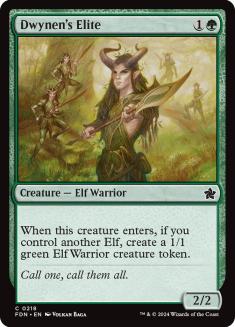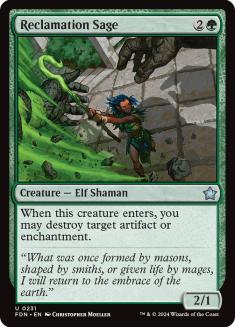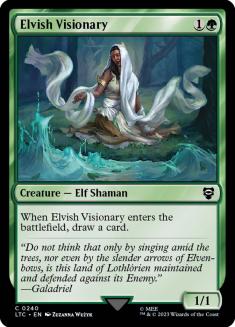It’s been over five years since I registered Elves in a Legacy tournament. When you account for the time dilation factor of COVID-19, that means it’s been almost 30 years. Trust me, I’m a number scientist.
But some things never change, and for better or worse, I’ll always be The Elves Guy™ to some degree. That means when the tribe got some exciting new cards in Kaldheim, it behooved me to explore their potential in various formats. They’ve thus far fallen flat in Kaldheim Standard, but I knew Realmwalker’s best home would be found in older formats where the card pool for a single tribe is much deeper.
It may be an Elf only in a technical sense, but Realmwalker was always destined to join the pointy-eared brigade. Experimental Frenzy, an effect which compares similarly, always played best with a low curve, which Elves provide, and the mana that they’re known for making only makes it easier to keep churning through your deck. That mana also lets you lower your land count and increase your creature density, so you’re more likely to hit a nice pocket of Elves to flood the battlefield.
We’ve seen Realmwalker in Modern Elves, but I’m always wary of creatures that cost three or more mana and die to Lightning Bolt in that format, because trading three mana for one mana puts you at a huge disadvantage. Combined with the number of Lava Darts that are around in the current Modern metagame, and I’m not too excited by the prospect of playing a deck that wants to untap with a battlefield full of 1/1 creatures.
However, Pioneer is a much more hospitable place for cheap creature decks. Mono-Black Aggro has long been a staple, along with Boros Wizards, Orzhov Auras, and now Naya Winota. The best cheap removal is confined to black, and Fatal Push is much harder to use with revolt when the only playable fetchland is Fabled Passage. That last part is especially important for Realmwalker, which demands an immediate answer because of how much potential there is for each turn you untap with it to snowball into an insurmountable advantage.
In addition to Realmwalker, I’m also excited about the prospect of Elvish Warmaster. Dwynen’s Elite is a long-time staple of Elves decks and Warcaller offers significantly more upside. With Collected Company you can make an additional token on your opponent’s turn, and the activated ability ensures that you’ll rarely flood. The potent combination of Elvish Archdruid and Ezuri, Renegade Leader isn’t available in Pioneer, so having a similar effect to break through stalled battlefields is quite welcome.
It may not have the combo potential of Glimpse of Nature or Devoted Druid, but with these new additions, Elves has the necessary power and resilience to compete with the various aggressive strategies in Pioneer. Here’s my current list:
Creatures (33)
- 4 Llanowar Elves
- 4 Elvish Visionary
- 4 Elvish Mystic
- 3 Dwynen's Elite
- 4 Shaman of the Pack
- 4 Elvish Clancaller
- 4 Realmwalker
- 4 Elvish Warmaster
- 2 Jaspera Sentinel
Lands (21)
Spells (6)

This list is designed to function as a classic, go-wide aggro deck, and that has informed every single card choice. But let’s take a closer look at some of the less common decisions:
Both of these cards made the list as ways to utilize the many creature tokens this deck creates. Elves decks always want to start the game with a mana creature, and past Llanowar Elves and Elvish Mystic, the choices are slim. Normally I’d be more apt to play Gnarlroot Trapper, which I think is underrated because of how its second ability makes it hard to defend your creature swarm in combat. But Trapper’s failure to accelerate into Collected Company on Turn 3 is a huge demerit that Sentinel doesn’t have. This deck generates enough spare bodies that fueling it isn’t a problem, so its downside is lesser than Trapper’s.
Chord of Calling is much more common to find in Elves decks, but I find it incredibly overrated — especially in decks whose cheap creatures primarily make mana. In order to use convoke effectively, you want a deck that generates creatures that aren’t otherwise useful for making mana or attacking. With Elvish Warmaster and Dwynen’s Elite, this deck does just that.
Remember that go-wide aggro decks often focus on building up their battlefield on the early turns, and aren’t as concerned with dealing early chip-shot damage. If they’re able to do this, their later attacks will be for huge amounts of damage, so the few points they miss out on early aren’t as relevant.
The exception here is against removal-heavy strategies, which have enough disruption to stop these synergies from coming together. Not only is chip-shot damage more important in these matchups, but their removal makes it hard to generate enough bodies for convoke in the first place. So it’s no surprise that Chord of Calling comes out in these matchups, which you’ll see reflected in the sideboard below. That weakness, along with how clunky it can be in multiples, is what led me to still only play two copies, though the third is something I’m interested in finding room for.
With so many Golgari dual lands available, the manabase is good enough that you can afford some utility lands. And because the Pioneer deck doesn’t play as many one-drops as Modern or Legacy lists, you can afford a colorless land at that.
These are the three options, and of them I’d say Nykthos, Shrine to Nyx is both the most common and worst of the group. Elvish Clancaller is the only card that provides multiple points of devotion, so you need three or four nontoken creatures in most cases before Nykthos starts generating extra mana. That’s about as win-more as it gets. Elves has always been a good deck at winning non-interactive games, so I don’t want a utility land that further helps in those games.
Westvale Abbey also looks like a win-more card, since it requires five creatures to transform into Ormendahl, Profane Prince. But since those creatures can be tokens, it’s much more reasonable to imagine using it as a finisher. My problem with Ormendahl is that it doesn’t seem like such a great finisher. It’s often going to be too slow in the matchups that are about speed, and in the more disruption-heavy matchups, there are too many common answers. Sweepers like Extinction Event and Shadows’ Verdict exile it; Teferi, Hero of Dominaria tucks it; and Agent of Treachery steals it. If I’m going all-in on an effect like this, I need it to be more reliable than Ormendahl is in the current metagame.
So we’re left with the old reliable — Mutavault. Simply put, it’s one of the best cards in all of Pioneer. And while it will never dominate a game, it’s great at dealing those last two or four points of damage to close out a game. That’s exactly what I want out of a utility land. Between it and Shaman of the Pack, this deck has a surprising amount of reach that your opponents will need to respect. But if they don’t maximize the value from their own cards, your token generators, Realmwalkers, and Collected Companies can win an attrition game.
It’s this dichotomy that I think has been missing in Pioneer Elves decks up until now. Without enough cards to provide resilience in the face of removal, they were forced to employ too linear a strategy. Now the tribe has enough tools to punish players for not having enough early disruption, without folding if they do. Mutavault is the last piece of that puzzle. Just remember that you can activate it with a Shaman of the Pack trigger on the stack to get an extra point through, and that it will be pumped by Elvish Clancaller.
I think the time for Steel Leaf Champion in dedicated Elves decks has passed now that Realmwalker is in the format. If you want to play the creatures with the best stats, Mono-Green and Golgari Company decks do that. But when you’re committing to a tribe, you’re doing so in order to build toward powerful synergies, and beyond having Elf in the type box, Steel Leaf Champion doesn’t help that plan. Every card you play that doesn’t help your strategy detracts from the other 59 cards in the deck, and this card isn’t powerful enough by itself to compensate.
The rest of the sideboard cards are unsurprising, but Lifecrafter’s Bestiary is one I’ve long been a fan of. There are plenty of sweepers around in Pioneer, because they’re the best options for containing aggressive decks given the relative dearth of good spot removal. Shapers’ Sanctuary is useless in the face of Deafening Clarion and Shadows’ Verdict, but Bestiary is a great card for playing through those sweepers. It also helps you find your other disruption like Thoughtseize or Assassin’s Trophy, which are important to break up your opponent’s synergies in a longer game.
Sideboard Guide
VS Five-Color Niv-Mizzet
Out:
In:
You don’t have trouble playing through their spot removal; it’s the sweepers that are the problem. Try to hold your Thoughtseizes until the turn before they get to five mana for Bring to Light to maximize your chance of taking one. I don’t like over-sideboarding by bringing in Assassin’s Trophy because if you become too reactive you play into their game, and they’re better it than you are.
VS Mono-Black Aggro
Out:
In:
My typical plan in this matchup is to beat them on the battlefield, since you can create battlefields that invalidate all their recursive threats. The problematic cards then are their flying creatures: Spawn of Mayhem and Rankle, Master of Pranks, as well as Kalitas, Traitor of Ghet from the sideboard. Save your removal for those threats whenever possible.
Sometimes they’ll bring out most of their cheap creatures for a pile of removal and try to shift into the control role. In that case you should treat them that way and sideboard differently.
Out:
In:
In either case, I don’t like Scavenging Ooze since the recursive threats aren’t the axis on which the matchup is contested and they have plenty of good answers for it.
VS Naya Winota
Out:
In:
This matchup comes down to a race more than any other. As such, I cut the most late-game-focused cards for as much removal as possible and mulligan aggressively for an explosive start. If you want more help in this matchup, I’d look at replacing the Fatal Pushes with Heartless Acts.
VS Dimir Control
Out:
In:
I’d prefer not to bring in the Trophies here, as with Five-Color Niv-Mizzet, but the threat of Kalitas is too great. If they don’t have it in their sideboard, feel free to leave in the third Dwynen’s Elite and a Clancaller.
VS Rakdos Arcanist
Out:
In:
This matchup is all about keeping their threats off the battlefield, so all the removal comes in alongside Scavenging Ooze. Clancaller is your worst threat against a pile of spot removal, so it comes out along with the Chords so that your creature count stays high for Collected Company.
VS Mono-Green Devotion
Out:
In:
This is another racing matchup, since the player with the most explosive start nearly always wins. I leave in an extra Chord of Calling because their clock isn’t quite as fast as Naya Winota’s, and I’d rather have greater access to Shaman of the Pack whenever possible. Grafdigger’s Cage can complicate that, but in my experience, Wishing for a card with Karn, the Great Creator that doesn’t impact that battlefield is only a viable option when they are already ahead.
VS Orzhov Auras (Lurrus)
Out:
In:
Another racing matchup, but one where you have additional interaction in the form of Reclamation Sage. Sram, Senior Edificer is always priority number one, but beyond that, you’re not concerned about how big their creatures get. They’re going to outsize you. What becomes a problem is when they have lifelink, flying, and vigilance. Those abilities are what makes it hard for you to win races and chump block, so prioritize cards with those keywords.
VS Jund Sacrifice
Out:
In:
Repeat after me: Mayhem Devil must die. Again. Mayhem Devil must die. Again. Mayhem. Devil. Must. Die.
Beyond that, I like keeping more Realmwalkers in because you need more help to overwhelm them on the battlefield since they have a bunch of medium-sized creatures. So instead more Chords and Sentinels come out.
VS Four-Color Fires
Out:
In:
These decks don’t have enough spot removal to warrant bringing in Shapers’ Sanctuary, so instead you get space for Assassin’s Trophy, which can stop a Transmogrify, destroy Fires of Invention, or stop a large Shark token from ambushing your attack. Matchups like these, where your opponent has so many angles of attack that the versatility of Assassin’s Trophy shines, are why I like it in synergy-driven decks that don’t have much space for removal.
You may be tempted to bring in Fatal Push to further stop their Transmogrify plan, but they aren’t reliant on that now that they have Esika’s Chariot. You have to keep your deck as lean as possible and make sure your Collected Companies hit reliably.
VS Azorius Spirits
Out:
In:
The Spirits matchup is all about who’s winning on the battlefield, so you want all your removal and to cut the cards that have the least immediate impact on the battlefield, which are Elvish Visionary and Realmwalker. Prioritize their lords with your removal since that’s how they win in combat and you can generally go wide enough to neutralize Nebelgast Herald and Shacklegeist.
You also want to punish them for tapping out on your end step with your instants as well as Elvish Clancaller activations, so try to anticipate how they will play and sequence your cards appropriately. Generally, the more ahead you are, the more willing you are to get into a staring contest where your four mana for Company stays up against their three mana for Spell Queller. If you fall behind or they’re forced to tap out, you’ll want to use your mana more aggressively.

